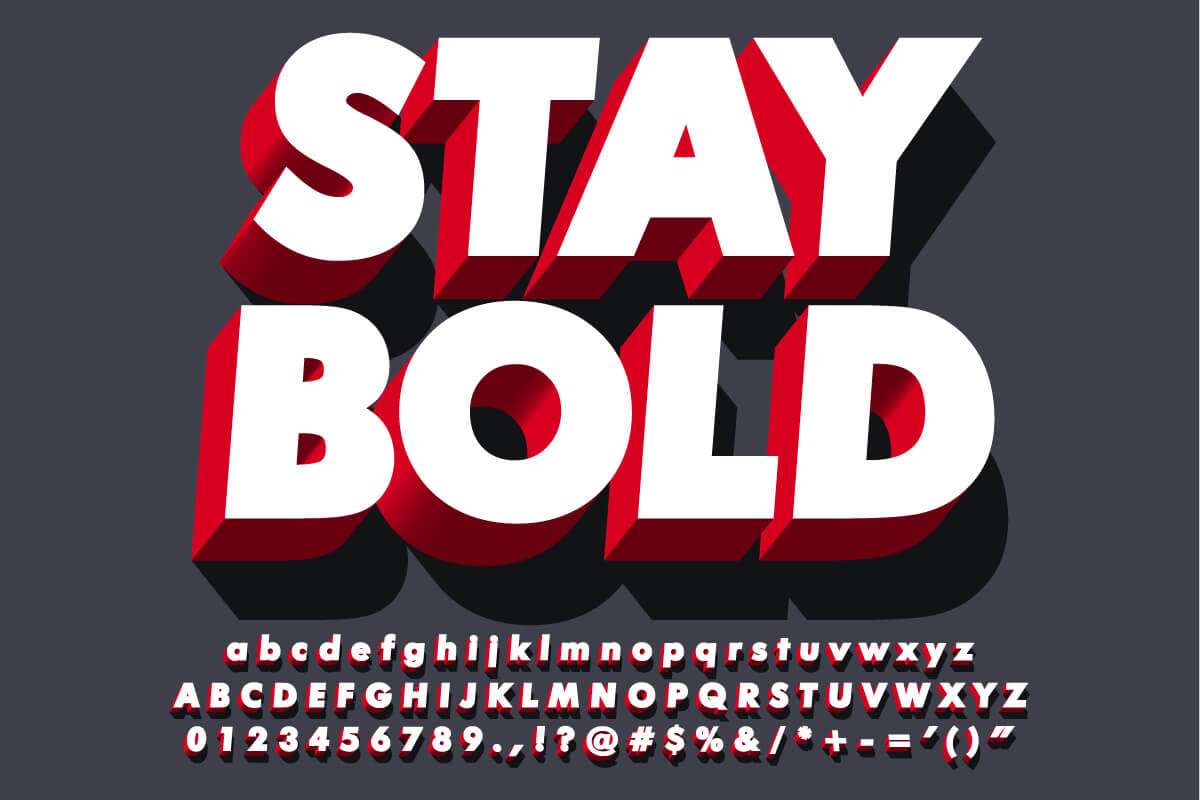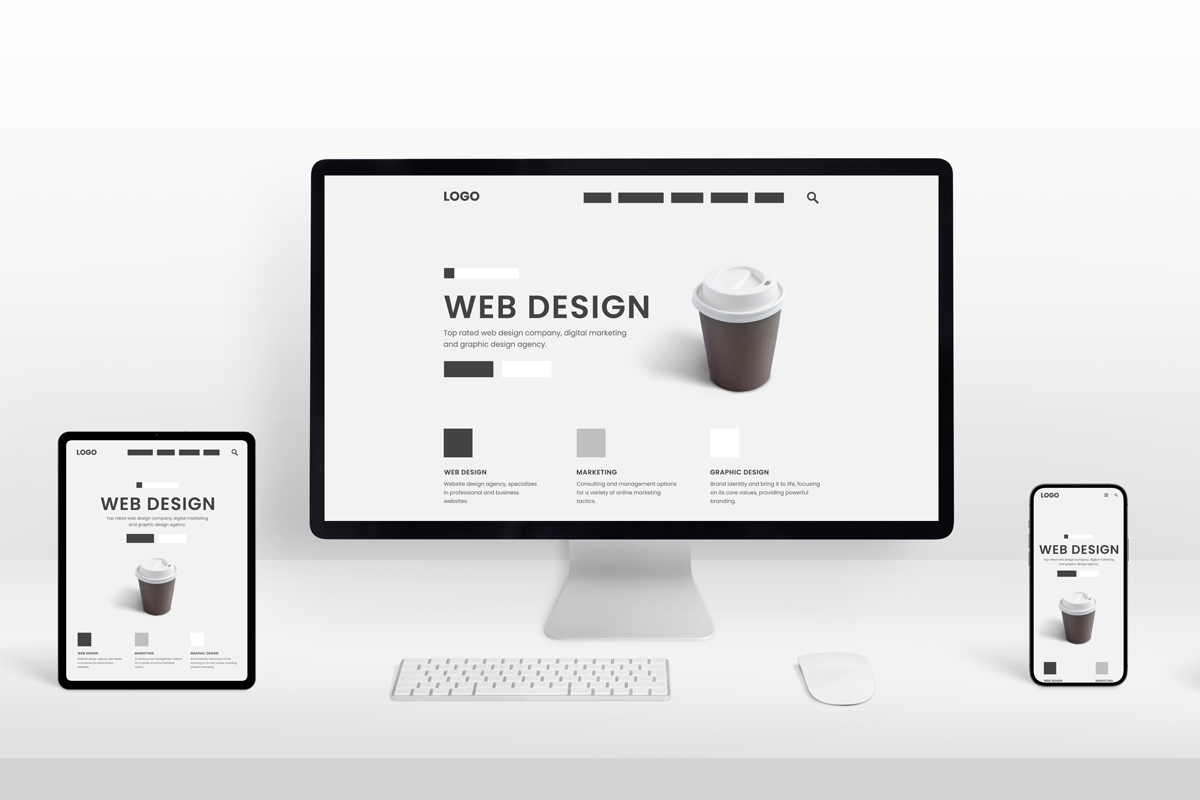We live in a world of dynamic web design, where visuals and fonts play a huge role in how a website looks, feels, and functions. Bold typography plays a crucial role in this equation, as it can significantly affect user experience and the overall effectiveness of a website. In this article, we’ll explore the impact of bold typography on user experience, discuss best practices and tips for creating effective, bold typography and look at how to test its impact.
Introduction to Bold Typography
Bold typography refers to using bold fonts and typefaces in web design. It can be used to emphasize certain words or phrases, create visual contrast, and draw attention to essential elements of a website. Bold typography is a powerful tool for improving user experience, as it can help guide users through a website and make it easier to find the information they’re looking for.
Nevertheless, excessive or ineffective use of bold typography can result in a negative user experience. It’s vital to comprehend how to implement bold typography effectively to generate a favorable user experience.
Benefits of Bold Typography
Bold typography is a useful tool for highlighting significant points or drawing attention to key elements of a website. This can simplify locating necessary information for users and enhance the website’s visual appeal.
Bold typography can also be used to create visual contrast and hierarchy. By using bold fonts for headings and regular fonts for body text, you can create a clear visual hierarchy that makes it easier for users to scan a page and find the information they’re looking for.
Finally, bold typography can be used to create a sense of urgency or importance. By emphasizing certain words or phrases, you can draw attention to important messages and create a sense of urgency that encourages users to take action.
Best Practices for Using Bold Typography
To effectively use bold typography, it is crucial to exercise restraint and reserve it for essential elements only. Overuse of bold typography can lead to a cluttered appearance and overwhelming user experience on a website. The placement of bold typography is also important; it should highlight important content rather than being used merely for aesthetic purposes.
Additionally, the selection of appropriate fonts plays a significant role. Although any font can be paired with bold typography, sans-serif fonts are preferable as they are easier to read and do not compete with other design elements on the page.
Lastly, it is essential to consider the size and weight of bold typography. It should be large enough to be easily read but not so large that it overshadows other page elements. The weight of bold fonts should also be appropriately balanced, drawing attention to the intended content without being too heavy-handed.
Examples of Effective Bold Typography
One of the most effective uses of bold typography can be seen in the navigation bar of many websites. By using bold fonts for headings and regular fonts for body text, you can create a clear visual hierarchy that makes it easier for users to find the information they’re looking for.
Bold typography can be effectively utilized to highlight crucial words or phrases, either by enlarging the font size or using a different weight. This method can emphasize essential messages and generate a sense of immediacy, urging users to act.
Moreover, bold typography can establish a visual distinction. By using bold fonts for headings and regular fonts for body text, a distinct visual hierarchy can be established that facilitates users’ scanning of a page and locating the information they need.
Choosing the Right Fonts for Bold Typography
When opting for fonts for bold typography, it’s crucial to factor in both font size and weight. Bold fonts should be legible enough to read effortlessly, yet not too sizable that they overpower the other page elements. They should also be bold enough to attract attention, yet not excessively bold to the point of appearing overwhelming.
Furthermore, font typeface should also be taken into account. Sans serif fonts tend to work better for bold typography since they are easier to read and do not clash with other page elements. Widely use fonts are sans serif fonts include Arial, Helvetica, and Open Sans.
Lastly, font style should be considered as different fonts exhibit distinct personalities. Therefore, it’s important to choose a font that suits the tone of your website. For instance, a traditional serif font like Times New Roman may be suitable for a law firm website, while a more modern sans serif font like Arial may be more fitting for a fashion brand’s website.

How Bold Typography Can Improve User Experience
Bold typography can have a significant impact on user experience. By emphasizing important words or phrases, it can provide convenient information they’re looking for. It can also instill a sense of urgency or importance that encourages users to take action. Finally, it can create visual contrast and hierarchy that makes it easier for users to scan a page and find the information they’re looking for.
By using bold typography effectively, you can create a positive user experience that encourages users to stay on your website and take action.
Challenges of Using Bold Typography
While bold typography can be a powerful tool for improving user experience, it can also be overused or used ineffectively, which can lead to a negative user experience. It’s important to understand how to use bold typography effectively in order to create a positive user experience.
For example, using too much bold typography can be overwhelming and can make a website look cluttered. It’s also important to use it in the right places; bold typography should be used to draw attention to important elements, not to simply make a website look more visually appealing.
Finally, it’s important to use the right fonts. While bold typography can be used with any font, some fonts are better suited for bold typography than others. Sans serif fonts tend to work better for bold typography, as they are easier to read and don’t compete with the other elements on the page.
How to Test the Impact of Bold Typography on User Experience
Conducting tests to determine the effect of bold typography on user experience is a vital aspect of web design. By assessing how users react to different fonts and typefaces, you can guarantee that you’re utilizing bold typography effectively and creating a positive user experience.
A/B testing is one of the most useful tools for evaluating the impact of bold typography. This testing technique involves comparing two website versions to determine which one performs better. For instance, you could create two website versions—one with bold typography and the other without—and compare them to see which one yields better results.
In addition, user surveys and feedback can also provide insight into how users respond to bold typography. Inquiring about which page elements catch their attention and their overall impression of the design can provide valuable feedback on how to enhance user experience.
Conclusion
Bold typography is an important part of web design, as it can significantly impact user experience and the overall success of a website. When used effectively, bold typography can create a positive user experience that encourages users to stay on a website and take action. However, it can also be overused or used ineffectively, which can lead to a negative user experience.
By understanding how to use bold typography effectively and testing its impact on user experience, you can ensure that you’re creating a positive user experience that encourages users to take action.
To inquire how to use bold typography to improve user experience, contact Tomorrow Web Design today. We can help you create a website that looks great, functions well, and provides a positive user experience.
Table of Contents
- Introduction to Bold Typography
- Benefits of Bold Typography
- Best Practices for Using Bold Typography
- Examples of Effective Bold Typography
- Choosing the Right Fonts for Bold Typography
- How Bold Typography Can Improve User Experience
- Challenges of Using Bold Typography
- How to Test the Impact of Bold Typography on User Experience
Share on
We live in a world of dynamic web design, where visuals and fonts play a huge role in how a website looks, feels, and functions. Bold typography plays a crucial role in this equation, as it can significantly affect user experience and the overall effectiveness of a website. In this article, we’ll explore the impact of bold typography on user experience, discuss best practices and tips for creating effective, bold typography and look at how to test its impact.
Introduction to Bold Typography
Bold typography refers to using bold fonts and typefaces in web design. It can be used to emphasize certain words or phrases, create visual contrast, and draw attention to essential elements of a website. Bold typography is a powerful tool for improving user experience, as it can help guide users through a website and make it easier to find the information they’re looking for.
Nevertheless, excessive or ineffective use of bold typography can result in a negative user experience. It’s vital to comprehend how to implement bold typography effectively to generate a favorable user experience.
Benefits of Bold Typography
Bold typography is a useful tool for highlighting significant points or drawing attention to key elements of a website. This can simplify locating necessary information for users and enhance the website’s visual appeal.
Bold typography can also be used to create visual contrast and hierarchy. By using bold fonts for headings and regular fonts for body text, you can create a clear visual hierarchy that makes it easier for users to scan a page and find the information they’re looking for.
Finally, bold typography can be used to create a sense of urgency or importance. By emphasizing certain words or phrases, you can draw attention to important messages and create a sense of urgency that encourages users to take action.
Best Practices for Using Bold Typography
To effectively use bold typography, it is crucial to exercise restraint and reserve it for essential elements only. Overuse of bold typography can lead to a cluttered appearance and overwhelming user experience on a website. The placement of bold typography is also important; it should highlight important content rather than being used merely for aesthetic purposes.
Additionally, the selection of appropriate fonts plays a significant role. Although any font can be paired with bold typography, sans-serif fonts are preferable as they are easier to read and do not compete with other design elements on the page.
Lastly, it is essential to consider the size and weight of bold typography. It should be large enough to be easily read but not so large that it overshadows other page elements. The weight of bold fonts should also be appropriately balanced, drawing attention to the intended content without being too heavy-handed.
Examples of Effective Bold Typography
One of the most effective uses of bold typography can be seen in the navigation bar of many websites. By using bold fonts for headings and regular fonts for body text, you can create a clear visual hierarchy that makes it easier for users to find the information they’re looking for.
Bold typography can be effectively utilized to highlight crucial words or phrases, either by enlarging the font size or using a different weight. This method can emphasize essential messages and generate a sense of immediacy, urging users to act.
Moreover, bold typography can establish a visual distinction. By using bold fonts for headings and regular fonts for body text, a distinct visual hierarchy can be established that facilitates users’ scanning of a page and locating the information they need.
Choosing the Right Fonts for Bold Typography
When opting for fonts for bold typography, it’s crucial to factor in both font size and weight. Bold fonts should be legible enough to read effortlessly, yet not too sizable that they overpower the other page elements. They should also be bold enough to attract attention, yet not excessively bold to the point of appearing overwhelming.
Furthermore, font typeface should also be taken into account. Sans serif fonts tend to work better for bold typography since they are easier to read and do not clash with other page elements. Widely use fonts are sans serif fonts include Arial, Helvetica, and Open Sans.
Lastly, font style should be considered as different fonts exhibit distinct personalities. Therefore, it’s important to choose a font that suits the tone of your website. For instance, a traditional serif font like Times New Roman may be suitable for a law firm website, while a more modern sans serif font like Arial may be more fitting for a fashion brand’s website.

How Bold Typography Can Improve User Experience
Bold typography can have a significant impact on user experience. By emphasizing important words or phrases, it can provide convenient information they’re looking for. It can also instill a sense of urgency or importance that encourages users to take action. Finally, it can create visual contrast and hierarchy that makes it easier for users to scan a page and find the information they’re looking for.
By using bold typography effectively, you can create a positive user experience that encourages users to stay on your website and take action.
Challenges of Using Bold Typography
While bold typography can be a powerful tool for improving user experience, it can also be overused or used ineffectively, which can lead to a negative user experience. It’s important to understand how to use bold typography effectively in order to create a positive user experience.
For example, using too much bold typography can be overwhelming and can make a website look cluttered. It’s also important to use it in the right places; bold typography should be used to draw attention to important elements, not to simply make a website look more visually appealing.
Finally, it’s important to use the right fonts. While bold typography can be used with any font, some fonts are better suited for bold typography than others. Sans serif fonts tend to work better for bold typography, as they are easier to read and don’t compete with the other elements on the page.
How to Test the Impact of Bold Typography on User Experience
Conducting tests to determine the effect of bold typography on user experience is a vital aspect of web design. By assessing how users react to different fonts and typefaces, you can guarantee that you’re utilizing bold typography effectively and creating a positive user experience.
A/B testing is one of the most useful tools for evaluating the impact of bold typography. This testing technique involves comparing two website versions to determine which one performs better. For instance, you could create two website versions—one with bold typography and the other without—and compare them to see which one yields better results.
In addition, user surveys and feedback can also provide insight into how users respond to bold typography. Inquiring about which page elements catch their attention and their overall impression of the design can provide valuable feedback on how to enhance user experience.
Conclusion
Bold typography is an important part of web design, as it can significantly impact user experience and the overall success of a website. When used effectively, bold typography can create a positive user experience that encourages users to stay on a website and take action. However, it can also be overused or used ineffectively, which can lead to a negative user experience.
By understanding how to use bold typography effectively and testing its impact on user experience, you can ensure that you’re creating a positive user experience that encourages users to take action.
To inquire how to use bold typography to improve user experience, contact Tomorrow Web Design today. We can help you create a website that looks great, functions well, and provides a positive user experience.




